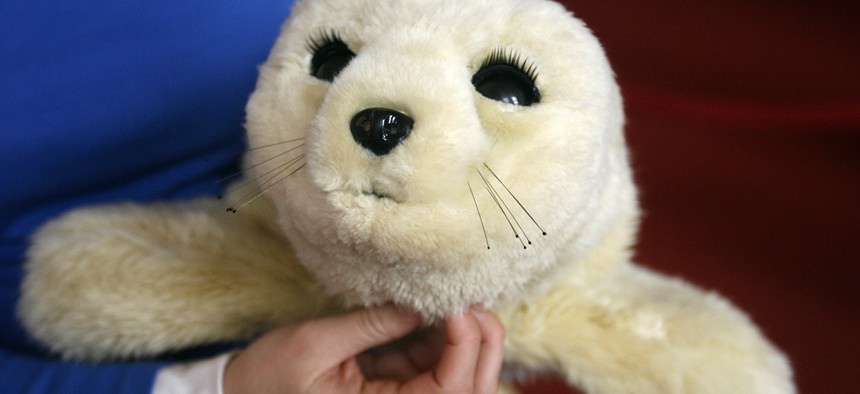Our Weird Future of Loving Robotic Pets

Paro, a therapeutic seal robot that reacts to human touch Jacquelyn Martin/AP Photo
These high-tech robots are a far cry from the Tamagotchis and Furbys of yesteryear
It took tens of thousands of years for humans to domesticate dogs. But it’s taken us just a few decades to invent robot versions of our furry companions.
Perhaps the most famous is the $6,000 robotic harp seal known as Paro, which took a star turn in an episode of Aziz Ansari’s series "Master of None" on Netflix. Then, there are the animatronic cats made by Hasbro’s Joy For All, recently bestowed with a “Letter of Recommendation” in The New York Times.
These high-tech robots are a far cry from the Tamagotchis and Furbys of yesteryear, which were marketed and priced as toys, not companions. Robo-pets are meant to provide their owners with companionship and emotional support. But can a bundle of wires really hold a candle to the living, breathing furballs we love?
For the senior demographic, at least, the answer would seem to be yes.
“No litter box, just love,” quips Ted Fischer, vice president of business development at Hasbro, which produces Joy for All cats, designed for elderly people. “One of the biggest reasons folks can no longer have a real pet is because of the care and feeding, or the constant need for in and out, or constant clean up. We wanted to eliminate that.”
The Joy For All felines can do many of the things that delight cat owners. They’re set in a permanent lying-down position, so they can’t walk. But they will roll over onto their backs to get a belly rub. They make a purring sound when they’re pet behind the ears, and respond to touch and movement with a degree of randomness, so it’s unpredictable when you’ll get a meow or a nuzzle. If you ignore them for long enough, they will “fall asleep” for a while.
It’s true that these cats have limitations. They can’t, for example, jump on your bed in the morning and curl up with you under the covers. But if they can’t deliver an exact replica of the experience of being a pet owner, they at least offer an approximation—and that may be better than nothing.
The human-animal bond, after all, has been shown to offer a host of benefits. Studies have shown that interacting with animals can ease symptoms associated with post-traumatic stress disorder, depression, Alzheimer’s, autism, and more.
According to the Center for Disease Control, quality time with an animal can also reduce everything from blood pressure to cholesterol to feelings of loneliness. And on a basic level, pets provide people with the opportunity to love and care for another being—an experience that’s central to our humanity.
Research suggests that at least some of these same benefits can extend to owners of robotic pets. As a recent article in The Atlantic reported, a 2009 study (pdf) found that almost 80 percent of children between the ages of 7 and 15 felt they would appreciate the companionship of the Sony Aibo, a robotic dog with artificial intelligence, if they were sad.
The study also found that while both children and adults knew Aibo was not a real animal, that didn’t stop them from caring about it. Similarly, a 2013 study of 40 elderly people at a retirement home, published in JAMDA, found that interactions with the robotic seal Paro made participants feel less lonely and stimulated conversations between residents.
We don’t yet have definitive research on whether robot pets can produce the same long-term psychological and health effects in humans. But we do know the pets created by Hasbro and other companies are surprisingly good at eliciting similar responses one would expect from interaction with a real cat, dog, or unusually friendly harp seal.
“When my grandmother ran her hand along Kitty’s faux fur, and I saw that smile overtake her face, something changed,” Jeremy D. Larson writes in his Times article about his 91-year-old grandmother’s Joy for All cat. “Our relationship is burdened by her lack of memory, but hers with Kitty is freed by it.”
That said, the rising popularity of robotic pets does raise some philosophical questions. Technology may be capable of serving some of the same emotional functions as living creatures—but what do we lose when we love something that can’t love us back?
Clinical psychologist Sherry Turkle worries that affection for a machine is misplaced, as robots are incapable of relating to humans.
“What can something that does not have a life cycle know about your death, or about your pain?” she asks in an interview with MIT. Her concern brings to mind the famous study of baby rhesus monkeys “raised” mothers made of wire. The baby monkeys ultimately suffered permanent emotional damage.
In contrast to robotic pets, domesticated animals like dogs have been shown to be deeply attuned to human emotions. While we’re still learning about how animals think, it is clear our alliance with pets is a two-way street.
Hasbro notes that Joy for All companions aren’t intended to encourage people to jettison their real-life felines.
“We aren’t trying to fool anyone that this is a real animal,” Fischer says. “I don’t see animatronic pets replacing real pets, for people who want real pets.”
Still, we should consider the implications of using robots to offer care to children or the elderly. Grandma may love Kitty, but it’s not a substitute for visits from her family. When we offload responsibility for providing emotional support to a machine, we risk losing some of our own humanity in the process.
NEXT STORY: Why Virtual Health Care Won't Work for Everyone





